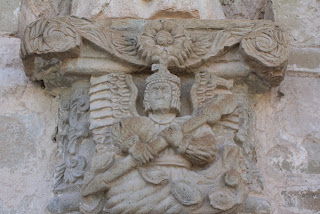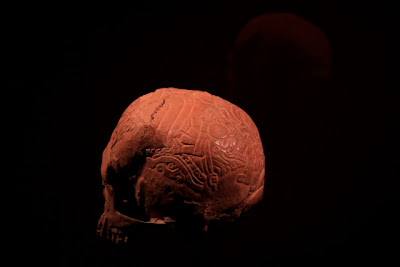July 4th -
Our first class session went very well. We stayed inside most of the day (at the Fundación Bustamante Vasconselos), and Dr. Wood and Dr. Lancaster introduced us to the program and each other. I thoroughly enjoyed a torta con tinga de pollo y queso for lunch; however, not knowing exactly what is in “tinga” meant, I was then thoroughly teased about what might be in tinga. This was my first “cart” meal at the delicious La Hormiga carta in the Parque de Paseo Juarez de Llano. My colleagues are top-shelf educators, many with decades of experience. The word “intimidating” comes to my mind. I know I will learn a lot from them, and I hope I can provide some useful knowledge to our discussions.
Learning experiences:
Dr. Wood introduced us to both Mayan hieroglyphic decoding and Nahuatl place-name glyphs.
I feel (almost) certain that I can write “chocolate” in Mayan glyphs, which is an achievement that might impress someone in the future. Needless to say, I am thoroughly excited for what is coming in our second week when the spotlight shifts to ethnographic lessons with ancient texts.
Later, Dr. Swanton, the linguistic specialist working at the Burgoa and the San Pablo libraries here in Oaxaca, described the vital role native Oaxacans are playing in maintaining their culture through language. Significantly, Swanton showed our group part of a recent video produced by one group of young Zapotecs (Beni Zaa), which was a Beni Zaa audio-dub for “An Inconvenient Truth” by Al Gore. Swanton played an excerpt from a documentary about the project, and it was wonderful to see the youth of a culture taking such an active role in maintaining their language.
Swanton brought props, specifically a type of coa or maize-planter stick traditional to the Americas, as well as an amazing palm leaf “raincoat” used by coastal Oaxacans from time immemorial (sorry, no pictures).
Questions:
In regards to some of the local indigenous language-speaking colleagues (“subject” having a derogatory connotation) he has worked with, Swanton mentioned the concept of “absolute orientation” or grounded relativity in linguistic cognitions, which he contrasted against “relative orientation.” First, I would need to do far more linguistic research than I might ever care for, but the question arises, what aspects of linguistic orientation are present in the key pre- and colonial terms I am focusing on for my thesis? Urban planning and the layout of religious or sacred structures appear to have had commonalities across Mesoamerica. What cultural linguistic significance did the indigenous terms for “temple,” “school,” and the like have in the communities that they served?
Also, Swanton described an aspect of “temporality” in Mayan. For example the English phrase “I kick the table.” Can mean the subject is in the process of kicking the object without actually completing the act; whereas in Mayan, at least with some verbs, the speaker would not use the verb unless the subject had completed the action (and actually kicked the table). I believe this is similar to what the Navajo (Dine) call “the process of becoming.” What aspects of this concept can I find in the development of a pre-Colonial indigenous student, and how did this concept complicate Colonial education?

































